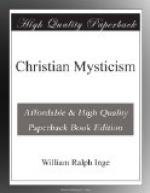[Footnote 17: In Plotinus the civic virtues precede the cathartic; but they are not, as with some perverse mystics, considered to lie outside the path of ascent.]
[Footnote 18: Tauler is careful to put social service on its true basis. “One can spin,” he says, “another can make shoes; and all these are gifts of the Holy Ghost. I tell you, if I were not a priest, I should esteem it a great gift that I was able to make shoes, and would try to make them so well as to be a pattern to all.” In a later Lecture I shall revert to the charge of indolent neglect of duties, so often preferred against the mystics.]
[Footnote 19: R.L. Nettleship, Remains.]
[Footnote 20: In a Roman Catholic manual I find: “Non raro sub nomine theologiae mysticae intelligitur etiam ascesis, sed immerito. Nam ascesis consuetas tantum et tritas perfectionis semitas ostendit, mystica autem adhuc excellentiorem viam demonstrat.” This is to identify “mystical theology” with the higher rungs of the ladder. It has been used in this curious manner from the Middle Ages. Ribet says, “La mystique, comme science speciale, fait partie de la theologie ascetique”; that part, namely, “dans lequel l’homme est reduit a la passivite par l’action souveraine de Dieu.” “L’ascese” is defined as “l’ascension de l’ame vers Dieu.”]
[Footnote 21: Cf. Professor W. Wallace’s collected Lectures and Essays, p. 276.]
[Footnote 22: See Appendix C on the Doctrine of Deification.]
[Footnote 23: So Fenelon, after asserting the truth of mystical “transformation,” adds: “It is false to say that transformation is a deification of the real and natural soul, or a hypostatic union, or an unalterable conformity with God.”]
[Footnote 24: Life of Tennyson, vol. i. p. 320. The curious experience, that the repetition of his own name induced a kind of trance, is used by the poet in his beautiful mystical poem, “The Ancient Sage.” It would, indeed, have been equally easy to illustrate this topic from Wordsworth’s prose and Tennyson’s poetry.]
[Footnote 25: See the very interesting note in Harnack, History of Dogma, vol. i. p. 53.]
[Footnote 26: The Abbe Migne says truly, “Ceux qui traitent les mystiques de visionnaires seraient fort etonnes de voir quel peu de cas ils font des visions en elles-memes.” And St. Bonaventura says of visions, “Nec faciunt sanctum nec ostendunt: alioquin Balaam sanctus esset, et asina, quae vidit Angelum.”]
[Footnote 27: The following passage from St. Francis de Sales is much to the same effect as those referred to in the text: “Les philosophes mesmes ont recogneu certaines especes d’extases naturelles faictes par la vehemente application de l’esprit a la consideration des choses relevees. Une marque de la bonne et sainete extase est qu’elle ne se prend ny attache jamais tant a l’entendement qu’a la volonte, laquelle elle esmeut, eschauffe, et remplit d’une puissante affection envers Dieu; de maniere que si l’extase est plus belle que bonne, plus lumineuse qu’affective, elle est grandement douteuse et digne de soupcon.”]




